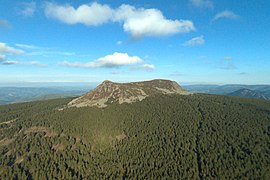Our website is made possible by displaying online advertisements to our visitors.
Please consider supporting us by disabling your ad blocker.
Haute-Loire
Haute-Loire
Naut Léger (Occitan) | |
|---|---|
|
From top to bottom, left to right: Mont Mézenc, prefecture building in Le Puy-en-Velay, and St Julien Basilica in Brioude | |
 Location of Haute-Loire in France | |
| Coordinates: 45°0′N 4°0′E / 45.000°N 4.000°E | |
| Country | France |
| Region | Auvergne-Rhône-Alpes |
| Prefecture | Le Puy-en-Velay |
| Subprefectures | Brioude Yssingeaux |
| Government | |
| • President of the Departmental Council | Marie-Agnès Petit[1] (LR) |
| Area | |
• Total | 4,977 km2 (1,922 sq mi) |
| Population (2022)[2] | |
• Total | 228,161 |
| • Rank | 87th |
| • Density | 46/km2 (120/sq mi) |
| Time zone | UTC+1 (CET) |
| • Summer (DST) | UTC+2 (CEST) |
| Department number | 43 |
| Arrondissements | 3 |
| Cantons | 19 |
| Communes | 257 |
| ^1 French Land Register data, which exclude estuaries and lakes, ponds and glaciers larger than 1 km2 | |
Haute-Loire (French pronunciation: [ot lwaʁ] ⓘ; Occitan: Naut Léger or Naut Leir; English: Upper Loire) is a landlocked department in the Auvergne-Rhône-Alpes region of south-central France. Named after the Loire River, it is surrounded by the departments of Loire, Ardèche, Lozère, Cantal and Puy-de-Dôme. In 2019, it had a population of 227,570;[3] its inhabitants are called Altiligériens in French (English : Altiligerians).
The department, which has its prefecture in Le Puy-en-Velay, covers the upper reaches of the Loire and consists of the Loire Valley and the surrounding mountains in the Massif Central. It is one of the original 83 departments of France created in 1790 during the French Revolution. Parts of the department are included in the Livradois-Forez Regional Natural Park.
- ^ "Répertoire national des élus: les conseillers départementaux". data.gouv.fr, Plateforme ouverte des données publiques françaises (in French). 4 May 2022.
- ^ "Populations de référence 2022" (in French). The National Institute of Statistics and Economic Studies. 19 December 2024.
- ^ Populations légales 2019: 43 Haute-Loire, INSEE
Previous Page Next Page







